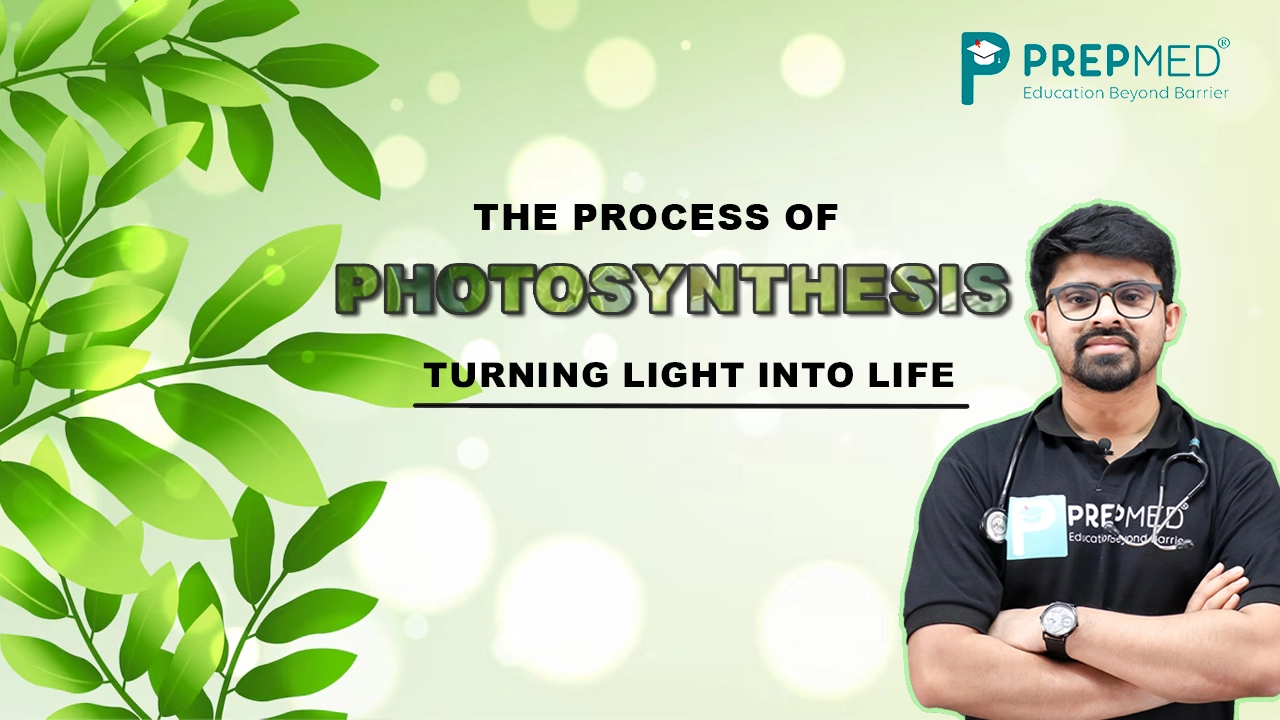December 20, 2024
The Process of Photosynthesis: Turning Light into Life
Photosynthesis is the process that is used by all green plants to synthesize their own food. Photosynthesis is mainly crucial for two key reasons:
- It is the foremost system for providing food on the surface of the Earth.
- The green plants release oxygen into the atmosphere that is utilized by all living organisms and human beings during the process of respiration.
Chemical energy is formed from water and carbon dioxide and stored in the form of sugars. Photosynthesis takes place in the chloroplasts with the help of various pigments such as chlorophyll a, xanthophyll, carotene, and chlorophyll b. All green plants prepare their food and nutrients by the process of photosynthesis using water, light, and carbon dioxide.
The Science behind photosynthesis
Photosynthesis is not only used by green plants, but also cyanobacteria, purple bacteria, and green sulfur bacteria. This process converts the solar energy into chemical energy and releases oxygen as the byproduct.
- Photosynthesis takes place when the green plants utilize the light energy and transforms carbon dioxide and water into glucose and oxygen.
- The presence of pigment, chlorophyll in the cell organelle chloroplast present in leaves, is where the photosynthesis takes place.
- Sugars, particularly glucose and fructose are another by-product of photosynthesis.
- These sugars are utilized by the plants as their energy source, that helps them to grow. These sugars then combine with each other to form large and complex carbohydrates like starch and cellulose.
Factors Affecting the process of Photosynthesis
According to Blackman's law of Limiting Factors, if more than one factor influences a chemical process, the factor that is closest to its minimal value will decide the process's rate since it is the one that has a direct impact on the process when its amount is altered.
- Light: Increased intensity of light will cause a higher rate of photosynthesis. Light saturation takes place at 10% of full sun exposure. Similarly lower light intensity causes the photosynthesis to be slow.
- The concentration of carbon dioxide: The main factor that determines the photosynthesis process. Especially carbon dioxide in the range of 350-400 PPM is enough for the photosynthesis to occur.
- Temperature: As you all know the enzymes related to the process of photosynthesis are sensitive to temperature. In photosynthesis, the light reactions happen under an ambient temperature of 25° C - 35° C.
- Water: One of the largest and significant factors of photosynthesis. Water deficiency can lead to low intake of carbon dioxide and can lead to various problems. In other words, plants facing water scarcity have stomatal closure, thereby hindering the process of photosynthesis.
Explaining the chemical equation and process
Plants, in the presence of light energy, can produce carbohydrates from carbon dioxide and water. The total photosynthesis can be explained with the reaction:
6CO2 + 6H2O —> C6H12O6 + 6O2
C6H12O6 is the carbohydrate (for example: glucose).
Cornelius Van Niel, based on his studies with the purple and green bacteria, concluded that photosynthesis is a light dependent reaction in which hydrogen reduces carbon dioxide to carbohydrates.
Certain bacteria that perform the process of photosynthesis, yet do not release oxygen as the by-product are called anoxygenic photosynthetic bacteria, and the ones that produce oxygen as the by-product are called oxygenic photosynthetic bacteria.
What are the major photosynthetic pigments involved in photosynthesis?
The major pigments involved in photosynthesis are:
- Chlorophyll a (bright or blue-green)
- Chlorophyll b (yellow-green)
- Carotenoids (yellow to yellow-orange)
- Xanthophylls (yellow)
Pigments also have the quality to absorb light in particular ways. Chlorophyll a is the most important of the chief pigments that is involved in the process of photosynthesis. Most of the photosynthesis occurs at the blue and red wavelength bands of light.
Note: Chlorophyll is the major pigment of photosynthesis. However, the other pigments like chlorophyll b, xanthophylls and carotenoids (also known as accessory pigments) are responsible for absorbing light and transferring the energy to chlorophyll a.
Steps of photosynthesis:
- When photosynthesis occurs, carbon dioxide makes its way through the stomata, water is absorbed from the hairs of the roots and is transported to the leaves via the xylem vessels. The fact that light energy from the sun is being absorbed by chlorophyll used to break the molecules of water into oxygen and hydrogen.
- The hydrogen and the carbon dioxide are jointly used to synthesize glucose. Moreover, oxygen is released out into the air through the green leaves as the major by-product.
- Glucose mainly provides energy, supporting growth and nurturing development, whereas the rest is stored in roots and other parts of the plants for later use.
- Pigments not only impart color absorb light and reflect back the unabsorbed light, but are also responsible to carry out the process of photosynthesis. The pigments, chlorophyll a, chlorophyll b, and carotenoids, present in the thylakoids of the chloroplast, are responsible for capturing light energy.
Steps of photosynthesis
The process of photosynthesis mainly occurs in two stages:
Light reaction (Light dependent reaction) :
- Light reaction of photosynthesis is carried out in the presence of sunlight during the day. Thylakoids of chloroplasts is the region where the light dependent reactions take place.
- The membrane-bound sac-like structures called grana, present inside the thylakoid, are responsible for gathering light and are known as photosystems.
- These photosystems contain large numbers of pigment and protein molecules confined in the chloroplasts of the plant cells and are chiefly involved in light reactions of photosynthesis.
- There are mainly two types of photosystems, they are: PS I and PS II.
- During the light reactions, the light energy is converted into ATP and NADPH, which are used during the dark reactions.
- In the light reaction, ATP and NADPH are synthesized through the two electron transport protein system, water is utilized and oxygen is evolved.
The light reaction mechanism can be explained by the reaction:
2H2O + 2NADP+ + 3ADP + 3Pi → O2 + 2NADPH + 3ATP
Dark reaction (Light independent reaction) :
- The other name given to the dark reaction is known as the carbon-fixing reaction.
- It is not dependent on sunlight and results in the formation of sugar molecules from water and carbon dioxide.
- This process of photosynthesis occurs in the stroma of chloroplast, where they utilize the ATP and NADPH of the light reaction.
- Plants absorb the carbon dioxide from the atmosphere via the stomata and proceed to the Calvin Photosynthesis Cycle.
- In the Calvin cycle, the ATP and NADPH formed during the light reaction carry out the process and convert six carbon dioxide molecules into one glucose molecule.
The dark reaction can be explained by the reaction:
3CO2 + 6 NADPH + 5H2O + 9ATP → G3P + 2H+ + 6 NADP+ + 9 ADP + 8 Pi
Where G3P is the glyceraldehyde 3-phosphate.
Importance of photosynthesis:
- Photosynthesis is probably the most significant process on planet earth, it sustains all life forms. It plays a big part in the food chain- the plants make their food through this process hence making them the producer.
- Photosynthesis also leads to the synthesis of oxygen – which is required by most organisms in the process of existence.
FAQS:
1. Where does the light reaction of photosynthesis take place and what are the end products of the reaction?
The light reaction takes place in the grana of the chloroplast and produces ATP and NADPH as the end product.
2. What do you mean by carboxylation?
Carboxylation is the process of the fixation of carbon dioxide into a stable organic intermediate. The carboxylation is the most crucial step of the Calvin cycle as carbon dioxide is used in the carboxylation of RuBP carboxylase, which leads to the production of 3-PGA.
3. What are the different absorption peaks of the two photosystems?
In PS I, the chlorophyll a has an absorption peak is at 700 nm, whereas in PS II, the absorption peak is at 680 nm.







